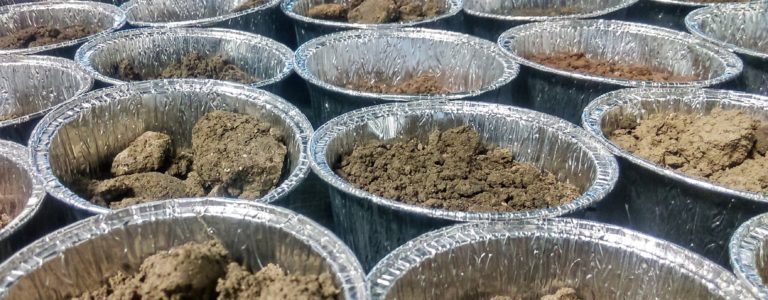Allotment Analysis: The Secret World of Soil Sampling

If you’ve been following MYHarvest on Facebook or Twitter, or read the last newsletter, you’re probably already aware that we spent most of last Summer surveying allotments across the country. The soil samples, management and crop area data we’ve been collecting will complement all the amazing data being submitted through MYHarvest (Thank You!). Though, what exactly are we collecting and what are we doing with it?
Last Summer, Miriam, Jill and Roscoe went to 100 allotment plots on 20 sites in five UK cities (see Summer Fieldwork news story). On each of these randomly selected allotments, we:
- Surveyed plot holders on how they manage their plots and their personal experience of having an allotment
- Mapped the areas allotmenteers are using to grow each crop on their plot
- Collected 1400 soil samples to analyse for various indicators of soil quality
Since collecting all of these samples, we’ve been busy processing the soil and preparing it for various analyses. This usually involves drying it in an oven and the slow process of grinding it into a fine powder.
Once prepared, we are planning to conduct the following analyses on the allotment soil samples:
- Bulk density – this indicates how compacted the soil is and how much pore space it has for soil organisms, plant roots and air and water flow. Low soil bulk density is desirable.
- pH – this is how acidic or alkaline the soil is. Plants can be quite specific about the pH of the soil they grow in, as the availability of different nutrients (and toxins) is closely linked to pH. A pH between 6-7 is optimal for most crop plants.
- Water Holding Capacity – this is how much water the soil can retain. This doesn’t just influence how much water will be available for crops at times of drought, but also how much water can be stored at times of heavy rain (reducing flooding). High water holding capacity is usually good.
- Total Nitrogen and Organic Carbon content – Carbon and nitrogen content are key indicators of soil health. Nitrogen is a key plant nutrient. Organic carbon is the main energy source for soil microorganisms that are fundamental to soil processes, and influences many other factors. High, though balanced, soil carbon and nitrogen content is desirable.
- Black Carbon content – black carbon is formed from partially burnt fossil fuels or biomass (such as wood). Unless intentionally added as biochar or mixed in after a bonfire, black carbon in soil will typically come from transport, domestic heating and industry. We are measuring black carbon concentration to understand how it effects nutrient availability to plants..
- Heavy Metal concentration – we want to measure the range of heavy metal concentrations in urban allotment soils across the country. Our aim is to better understand how plants uptake heavy metal in the soil and the real risk to health associated with growing crops in soils with high heavy metal concentrations.
There is a lot of useful and exciting information that may come out of this unique allotment data-set. This will be even more interesting when combined with the information you are submitting through MYHarvest.
We will be analysing these samples until the beginning of Summer 2018. Then we will go to another five cities to collect another 1400 allotment soil samples and start the whole process again! When completed, we will publish our findings and the results will be made available to the public


